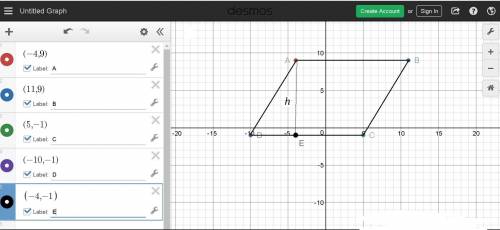
Mathematics, 13.07.2019 12:50 cuhh
What is the area of a parallelogram whose vertices are a(−4, 9) , b(11, 9) , c(5, −1) , and d(−10, −1) ?

Answers: 2


Another question on Mathematics

Mathematics, 21.06.2019 17:30
Monthly water bills for a city have a mean of $108.43 and a standard deviation of $32.09. find the probability that a randomly selected bill will have an amount greater than $155, which the city believes might indicate that someone is wasting water. would a bill that size be considered unusual?
Answers: 1

Mathematics, 21.06.2019 19:20
Which number line represents the solution set for the inequality - x 24?
Answers: 3

Mathematics, 21.06.2019 22:30
Acampus club held a bake sale as a fund raiser, selling coffee, muffins, and bacon and eggs sandwiches. the club members charged $1 for a cup of coffee, 3$ for a muffin , and $4 for a back. and egg sandwich. they sold a total of 55 items , easing $119. of the club members sold 5 more muffins than cups of coffee, how many bacon and egg sandwiches he’s did they sell
Answers: 1

Mathematics, 22.06.2019 00:00
The construction of copying qpr is started below. the next step is to set the width of the compass to the length of ab. how does this step ensure that a new angle will be congruent to the original angle? by using compass take the measures of angle and draw the same arc according to it.
Answers: 1
You know the right answer?
What is the area of a parallelogram whose vertices are a(−4, 9) , b(11, 9) , c(5, −1) , and d(−10, −...
Questions







Mathematics, 15.04.2020 22:19



Mathematics, 15.04.2020 22:20



Mathematics, 15.04.2020 22:20





English, 15.04.2020 22:20

English, 15.04.2020 22:20

Mathematics, 15.04.2020 22:20



















